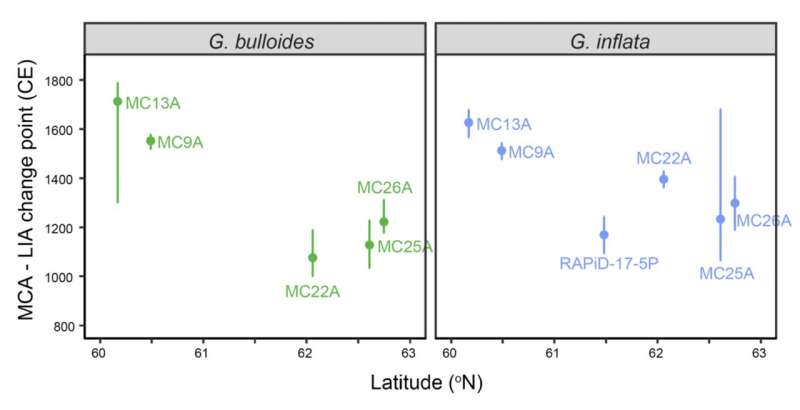This article has been reviewed according to Science X's editorial process and policies. Editors have highlighted the following attributes while ensuring the content's credibility:
fact-checked
peer-reviewed publication
trusted source
proofread
North Atlantic circulation found to have reduced historical changes in climate

Heat transferring from the surface to the deep ocean in the North Atlantic helped reduce climate swings during the last 1,000 years, according to a newly published paper led by researchers from the Woods Hole Oceanographic Institution (WHOI) and UCL.
The paper, published in Science, presents records from North Atlantic sediments that allowed the researchers to investigate temperature changes in the surface and deep ocean throughout the last 1,200 years. From these data the team was able to infer how the ocean has helped transfer heat from the surface to the deep ocean, causing it to reduce the size of past surface climate changes.
Co-author Professor David Thornalley (UCL Geography) said, "We only have direct measurements of deep ocean temperature from thermometers for the last 20 to 30 years. These direct measurements suggest that the deep ocean has been absorbing a lot of the heat caused by global warming. A key route for this heat to get from the surface and into the deep ocean is along pathways where water is sinking from the surface to the deep."
"We set out to investigate if heat has always been transmitted via one of these pathways in the North Atlantic over the last 1,000 years or so. This is the first time we have been able to measure the deep ocean temperature during this period, by indirect means, at a location in the pathway where waters are sinking down to the deep sea."
The researchers used samples from 11 sediment cores taken from south of Iceland, where overflows of cold, dense waters from the Nordic seas sink and fill the deep North Atlantic. These overflows are a part of the deep limb of the Atlantic Meridional Ocean Circulation (AMOC), which acts like a conveyor belt carrying warm surface water north from the equator and returning cool deep water south.
From the sediment cores, the researchers measured the chemistry of tiny shell fossils from foraminifera, single-celled organisms that live near the surface as well as in the deep water. This gave the researchers information about the ocean's environment when those foraminifera lived and formed their shells.
The sediment data agree with observations of recent surface and deep ocean warming. But the researcher's data also show a connection between the surface and the deep ocean throughout the last 1,200 years.
Lead author Dr. Wanyi Lu, a post-doctoral scientist at WHOI, said, "Our data provide strong support for the idea that the overflows have consistently transferred surface climate changes to the deep ocean throughout the past 1,200 years."
Over the last 1,200 years, the Earth's surface climate swung from the warm conditions of the Medieval Climate Anomaly (around 850-1250 Common Era, CE) into the cold Little Ice Age (spanning around 1400-1850 CE). Famously, the Little Ice Age is a period when frost fairs were held on the river Thames and there were extremely cold winters across Europe, linked to crop failures.
However, the new study shows how the deep North Atlantic prevented these climate changes from being much worse.
Dr. Lu said, "We provide evidence that the deep ocean cooled from the Medieval Climate Anomaly to the Little Ice Age. This means that the deep ocean gave heat back to the atmosphere, and therefore reduced Little Ice Age surface cooling. This is the same process—but acting in the opposite direction—that has caused the ocean to reduce modern surface warming."
The Earth's surface has gotten warmer in the past hundred years. However, the ocean has slowed this warming by absorbing and storing more than 90% of the excess heat.
Co-author Dr. Delia Oppo, a senior scientist and paleoceanographer at WHOI said, "People should understand how important the ocean is to their climate. Without the ocean uptake of heat, global warming would be even worse than it is."
However, there are concerns that the conveyor-like circulation of the AMOC may be slowing down.
Professor Thornalley said, "Our previous work at UCL found that the AMOC may have weakened during the 20th century. The results of our new study suggest that if the AMOC was stronger in the past than today, then the historic AMOC may have played a greater role transferring heat from the ocean surface to depth. If AMOC weakens in the future, it could lead to changes in the way heat is absorbed by the ocean as the climate warms."
"We only examined one process: how the AMOC transmits heat between the surface and the deep ocean via the overflow pathway. But other processes will occur as AMOC weakens, that cause it to store more heat. How much heat can be transferred and stored in the deep Atlantic in the future will depend on the balance of these different processes."
More information: Wanyi Lu et al, Surface climate signals transmitted rapidly to deep North Atlantic throughout last millennium, Science (2023). DOI: 10.1126/science.adf1646
Journal information: Science
Provided by University College London




















